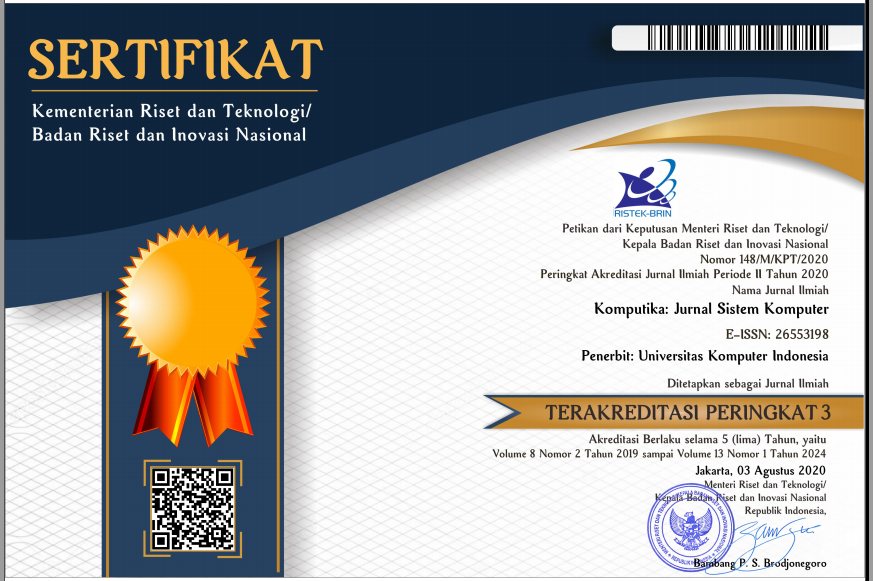Perancangan, Fabrikasi, dan Karakterisasi Transistor Bipolar
Perancangan, Fabrikasi, dan Karakterisasi Transistor Bipolar
DOI:
https://doi.org/10.34010/577k0697Abstract
Bipolar transistors still play an important and irreplaceable role in the application of electronic systems, even though almost all logic circuits, including microprocessors and memory, consist of MOS (Metal Oxide Semiconductor) transistors. They are widely used today due to their advantage higher switching speed compared to MOS technology and their ability to conduct high currents. In this research, the design, fabrication, and characterization of bipolar transistor were carried out. The design was done using L-Edit software and the converted to glass using a photoreduction camera. The base material for the transistors was n-type epitaxial wafer with a layer depth of 3 μm. The fabrication process involved wafer cleaning, oxidation, diffusion, photolithography, etching, metallization, and metal strengthening. Due to the use of a thin epitaxial wafer, thermal diffusion followed by a drive-in process was avoided to prevent penetration through the epitaxial layer, resulting in a low current gain (β) of only 1.5 times. On the other hand, using a thicker epitaxial layer would create difficulties during the isolation process. The success of each fabrication step was determined by measurement on test patterns, including resistor resistance measurement, diode characterization, and determination of diffusion depth using dummy samples. The measurement results showed an emitter junction depth of 0.3 μm, and a base layer width of 1.1 μm. These results indicate that the transistor was successfully fabrication, although with a low current gain.
Keywords – MOS; Epitaxial wafer; Diffusion; Current amplifier; Dummy.
References
[1] Schubert, T.F, Kim, E.M, Bipolar Junction Transistor Characteristic. In: Fundamentals of Electronics. Synthesis Lectures on Digital Circuits & Systems. Springer, Cham, 2015.
[2] Vasudevan, K, Bipolar Junction Transistors. Dalam Basic Electronic Circuits, Springer, 2023, pp. 109-134.
[3] Bogdanović, Filip & Osrečki, Željko & Žilak, Josip & Koricic, Marko & Suligoj, Tomislav, Comparison of Discrete Bipolar Transistors and MOSFETs for High-Speed Switching Application, 2021, pp. 22-27.
[4] Gu, R. X, Sharaf, K. M., & Elmasry, M. I, Series-Gated CML and ECL Bipolar Circuits. Dalam High-Performance Digital VLSI Circuit Design, Springer, 2019, pp. 179-205.
[5] Liu Y, Advantages of CMOS technology in very large scale integrated circuits. InProceedings of the 2021 2nd International Conference on Artificial Intelligence in Electronics Engineering 2021 Jan 15 pp. 82-88.
[6] Hilleringmann, Ulrich, Bipolar Technology, Silicon Semiconductor Technology: Processing and Integration of Microelectronic Devices. Wiesbaden: Springer Fachmedien Wiesbaden, 2023. Pp. 215-224.
[7] Kuzmicz. W, A Thermally Stable Quasi-CMOS Bipolar Logic. Electronics, 11(1), 2021, pp. 6.
[8] Han, X., Tan, H., Liu, W., Liang, B., & Zhou, Y, Modeling of Heterojunction Bipolar Transistors Based on Novel Wiener‐Type Dynamic Neural Network. International Journal of RF and Microwave Computer-Aided Engineering, 2022, 32(5).
[9] Williams, R.K., Darwish, M.N., Blanchard, R.A., Siemieniec, R., Rutter, P. and Kawaguchi, Y., The trench power MOSFET: Part I—History, technology, and prospects. IEEE transactions on electron devices, 64(3), 2017, pp.674-691.
[10] Sze, S. M., & Ng, K. K, Physics of Semiconductor Devices. Wiley-Interscience, 2006.
[11] Kumar, M. J., & Janardhanan, S. Fundamentals of Semiconductor Fabrication. Wiley, 2014.
[12] Neamen, D. A, Semiconductor Physics and Devices. McGraw-Hill Education, 2012.
[13] Kumar, M. J., & Janardhanan, S, Fundamentals of Semiconductor Fabrication. Wiley, 2014.
[14] Chen, L., et al, Role of Dummy Transistors in Reducing Process Variations in Advanced CMOS Technologies. Semiconductor Science and Technology, 33(10), 105001, 2018.
[15] Cullen, C, Learn Audio Electronics with Arduino: Practical Audio Circuits with Arduino Control. United Kingdom: Taylor & Francis, 2020.
[16] Sedra, A. S., & Smith, K. C, Microelectronic Circuits (7th ed.). Oxford University Press, 2014.
[17] Balkanski, M., Wallis, R. F, Semiconductor Physics and Applications. United Kingdom: OUP Oxford, 2000.
[18] Kumar, A., & Roy, A, Impact of Dummy Transistors on Performance of CMOS Circuits. Microelectronics Journal, 88, 2019, pp. 1–7.



















